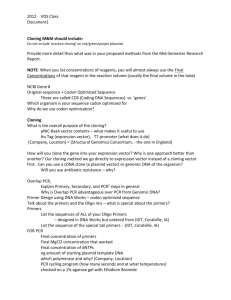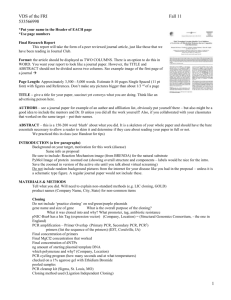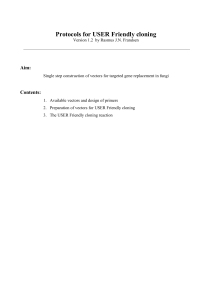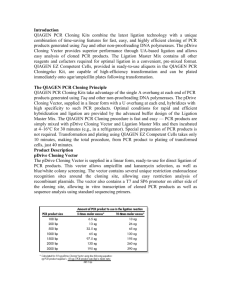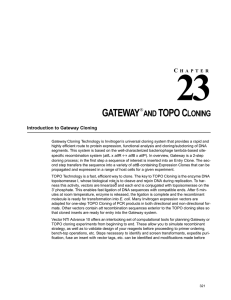Supplemental Digital Content Supplementary Methods Cell cultures
advertisement
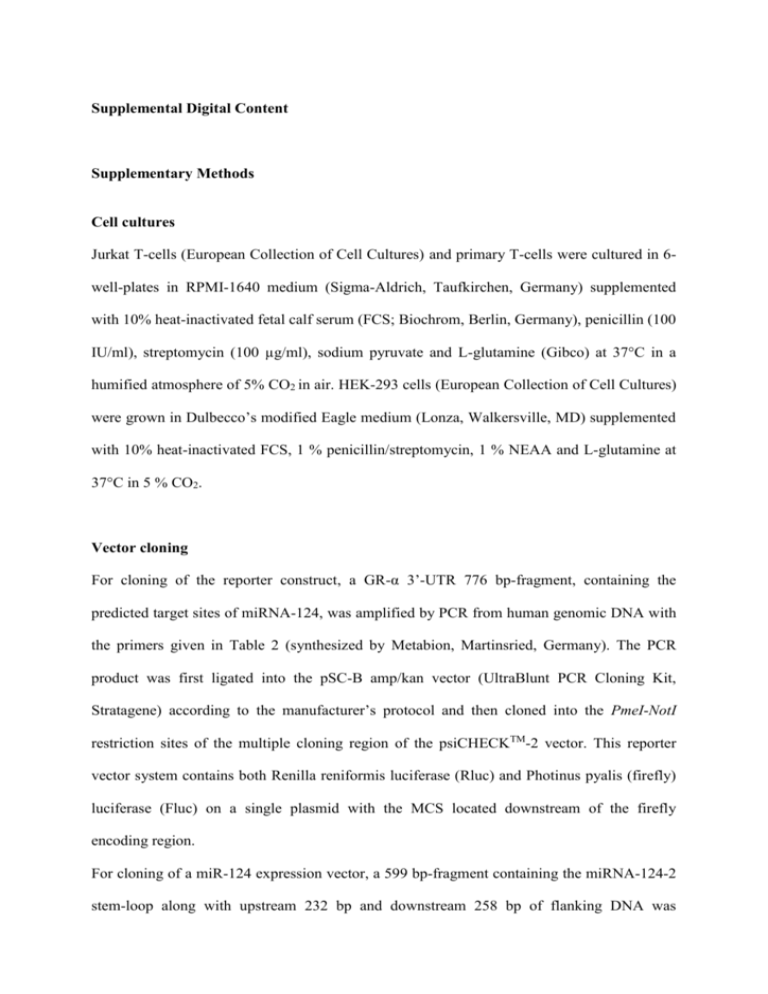
Supplemental Digital Content Supplementary Methods Cell cultures Jurkat T-cells (European Collection of Cell Cultures) and primary T-cells were cultured in 6well-plates in RPMI-1640 medium (Sigma-Aldrich, Taufkirchen, Germany) supplemented with 10% heat-inactivated fetal calf serum (FCS; Biochrom, Berlin, Germany), penicillin (100 IU/ml), streptomycin (100 µg/ml), sodium pyruvate and L-glutamine (Gibco) at 37°C in a humified atmosphere of 5% CO2 in air. HEK-293 cells (European Collection of Cell Cultures) were grown in Dulbecco’s modified Eagle medium (Lonza, Walkersville, MD) supplemented with 10% heat-inactivated FCS, 1 % penicillin/streptomycin, 1 % NEAA and L-glutamine at 37°C in 5 % CO2. Vector cloning For cloning of the reporter construct, a GR-α 3’-UTR 776 bp-fragment, containing the predicted target sites of miRNA-124, was amplified by PCR from human genomic DNA with the primers given in Table 2 (synthesized by Metabion, Martinsried, Germany). The PCR product was first ligated into the pSC-B amp/kan vector (UltraBlunt PCR Cloning Kit, Stratagene) according to the manufacturer’s protocol and then cloned into the PmeI-NotI restriction sites of the multiple cloning region of the psiCHECKTM-2 vector. This reporter vector system contains both Renilla reniformis luciferase (Rluc) and Photinus pyalis (firefly) luciferase (Fluc) on a single plasmid with the MCS located downstream of the firefly encoding region. For cloning of a miR-124 expression vector, a 599 bp-fragment containing the miRNA-124-2 stem-loop along with upstream 232 bp and downstream 258 bp of flanking DNA was amplified by PCR from human genomic DNA (primers are listed in Table 2). Cycling conditions comprised an initial denaturation step (95°C for 3 min), 35 cycles with 95°C for 30 s, 60°C for 30 s and 72°C for 30 s, and a final extension step of 72°C for 3 min. PCR products were analysed by agarosegelelectrophoresis, ligated into the pSC-B amp/kan vector (UltraBlunt PCR Cloning Kit, Stratagene) according to the manufacturer’s protocol and subsequently cloned into the BglII-PstI restriction sites of the multiple cloning region of the pmR-ZsGreen1 vector. Finally, the construct was verified by sequence analysis (MWG Biotech, Ebersberg, Germany); functionality was tested by transfection experiments with subsequent analysis of miR-124 by means of qPCR. Determination of transfection efficiency The transfection efficiency was analysed using the Attune® Cytometer (Applied Biosystems). Briefly, 1x106 transfected cells were transiently transfected either with 1 µg pmR-ZsGreen 1 vector, or with 50 nm Cy™3 dye-labeled Pre-miR™ Negative Control (Ambion) or with 50 nm DY-547-labeled siGLO RISC-Free Control siRNA (Dharmacon). 24 h after electroporation cells were harvested, washed twice with PBS and transferred to 5 ml polystyrene tubes in a total volume of 1 ml PBS. The fluorescent signal was detected using 488nm excitation with either a 530nm/30nm bandpass emission filter (ZsGreen 1) or a 575nm/24nm bandpass emission filter (Cy3 and DY-547). At least 10000 events per tube were measured. The transfection efficiency was calculated as the percentage of fluorescent cells in the total number of cells. Quantitative real-time RT-PCR Quantification of mRNA expression cDNA was synthesized from equal amounts of total RNA (1000 ng) using Superscript III reverse transcriptase (Invitrogen) and oligo(dT) and random hexamer primers following the supplier’s instructions. Quantitative RT-PCR was performed in duplicate on a LightCycler 480 instrument (Roche Diagnostics, Mannheim, Germany) using LightCycler 480 Probes Master and RealTime ready single assays (Roche Diagnostics) for IL-2 (Assay 100958) and for the reference genes SDHA (Assay ID 102136) and TBP (Assay ID 101145). The RealTime ready single assays contain target specific primers and a Universal ProbeLiberay LNA probe. Assays specifically amplifying the GR-α and GR-β isoform were designed using the ProbeFinder software (Roche Diagnostics). Primers and Universal ProbeLiberay LNA probes are listed in Table 2 (primer binding sites are illustrated in Figure 1). The cycling conditions comprised an initial denaturation phase at 95°C for 5 min, followed by 45 cycles at 95°C for 10 s, 60°C for 30 s and 72°C for 15 s; mRNA expression was normalized against SDHA and TBP expression, which have been proven to be suitable reference genes under the experimental conditions (28). PCR amplification efficiencies were determined by serial dilution standard curves, and relative GR-α and GR-β mRNA expression was calculated by the LightCycler Relative quantification software using an efficiency-corrected algorithm. Quantification of miRNA expression Equal amounts of RNA (10 ng) were reverse transcribed using miRNA-specific stem-loop primers and the TaqMan MicroRNA Reverse Transcription Kit (Applied Biosystems). Quantitative real-time PCR was performed in duplicate on the LightCycler 480 instrument, using LightCycler 480 Probes Master and applying the following cycling conditions: denaturing at 95°C for 10 min, 45 cycles of 95°C for 15 s and 60°C for 60 s. U6 RNA was used for normalization of miRNA expression data. Western Blotting For preparation of whole cell extracts, 2 million Jurkat cells were transiently transfected with 50 nM pre-miR-124 or pre-miR negative control using Neon Transfection System (Invitrogene). 24 hours after transfection, cells were harvested, washed with ice cold PBS, and resuspended in 500 µl lysisbuffer (50 mM Tris, 5mM EDTA, 150 mM NaCl, 1% triton X 100 (v/v), pH 7.3) supplemented with protease inhibitor cocktail set III (Calbiochem). Subsequently, cell lysates were sonified two times for 30 seconds and incubated on ice for further 10 minutes. Total protein extracts were finally collected by a centrifugation step for 10 minutes and 15 000 g at 4°C. Protein concentration was determined using Bradford assay (Bio-Rad). 30 µg of total protein extract were subjected to electrophoresis in a 10 % SDSPAGE and subsequently transferred onto PVDF-membrane. Non-specific binding sites on the membrane were blocked with 5% non-fat dry milk in PBST (PBS + 0.1% Tween-20). Antibodies were applied in PBST supplemented with 1% non-fat dry milk. GR-α protein was detected using anti-glucocorticoid receptor alpha rabbit polyclonal antibody (Thermo Scientific; 1:1000). Incubation with mouse monoclonal antibody AC-15 to β-actin (Sigma; 1:30000) served as a loading control. Immunoreactive bands were detected using horseradish peroxidise-labelled goat anti-mouse antibody (Cell Signaling Technologies; 1:10000) or stabilized goat anti-rabbit HRP conjugate (Pierce; 1:2000). Visualization was achieved using 20 x LumiGlo Reagent and 20 x Peroxide (CST). Supplementary Table 1: Characteristics of healthy volunteers Characteristics of healthy volunteers N 15 Age (years) 40.5 (± 5.5) Gender (male) 10 (66. 6 %) Nonsmokers, without suspect of any acute or chronical disease, blood count and electrolytes within normal ranges Supplementary Figure legends Figure S1: FACS Plots of purified T-cells. Transcripts 106 human T-cells were simultaneously counterstained with 10 nM Qdot 655 Anti-Human CD4 Antibody Conjugates and 10 nM Qdot 605 Anti-Human CD8 Antibody Conjugates (both Invitrogen) according to the manufacturer‘s recommendations. Fluorescence signals were analysed on an Attune® Acoustic Focusing Cytometer (Invitrogen) using 488 nm excitation with a 640 nm longpass filter (Qdot 655) and a 405 nm excitation with a 603nm/48nm bandpass filter (Qdot 605).


